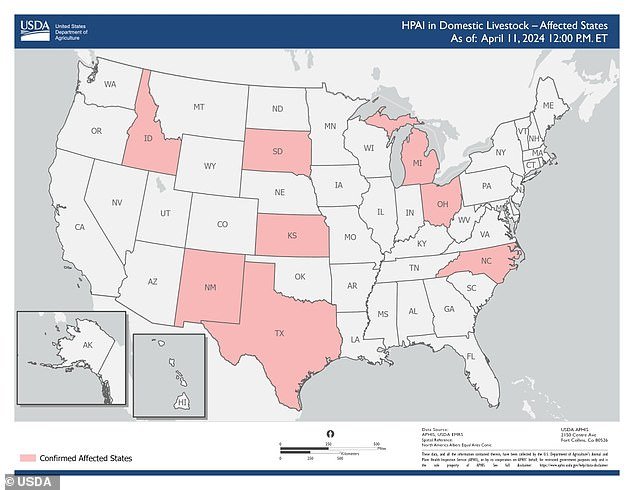H5N1 strain of bird flu is found in MILK for first time in ‘very high concentrations,’ World Health Organization warns
Bird flu has been found in “very high concentrations” in milk, health officials announced.
The World Health Organization (WHO) said Friday that bird flu, also known as H5N1, has been found in raw milk, milk that does not undergo standard pasteurization processes to remove bacteria.
Officials said pasteurized milk, which is standard at major retailers, is still safe.
Bird flu has been on the rise across the U.S. among cows and chickens, affecting animals on 29 farms in eight states, according to the CDC.
Last week, Dr. Darin Detwiler, former FDA and USDA Food Safety Advisor, told DailyMail.com that Americans should avoid rare meats and runny eggs while the outbreak in livestock was ongoing, because improperly cooked animal products are more likely to carry viruses and bacteria.
The World Health Organization said Friday that bird flu, also known as H5N1, has been found in unpasteurized milk, although pasteurized milk remains safe

The map above shows states with herds of livestock diagnosed with bird flu
Bird flu A(H5N1) first emerged in 1996, but since 2020 the number of outbreaks in birds has grown exponentially, alongside an increase in the number of infected mammals.
The species has caused the deaths of tens of millions of poultry, also infecting wild birds, terrestrial and marine mammals.
Cows and goats were added to the list last month. A surprising development for experts because it was thought that they were not susceptible to this type of flu.
Earlier this month, a Texas dairy farm worker became the second American ever to be infected with bird flu. Officials said his case was mild and he was recovering well.
Dr. Wenqing Zhang, head of the WHO’s global flu program, said: “The Texas case is the first case of a human being infected with bird flu from a cow.”
‘Bird-to-cow, cow-to-cow and cow-to-bird transmissions have also been recorded during these current outbreaks, suggesting that the virus may have found different transition routes than we previously understood.’
‘Now we are seeing multiple herds of cows affected in an increasing number of US states, showing a further step of the virus spillover to mammals.’
Dr. Zhang said there was a “very high concentration of virus in raw milk” from infected cows, but experts are still investigating exactly how long the virus can survive in milk.
The Texas Health Department has said the cattle infections are not a problem for the commercial milk supply because dairies must destroy milk from sick cows. Pasteurization also kills the virus.
“It is important that people ensure safe food practices, including consuming only pasteurized milk and milk products,” Dr. Zhang said.
From 2003 to April 1 this year, the WHO said it had recorded 463 deaths from 889 human cases in 23 countries, putting the death rate at 52 percent.
Dr. Zhang noted that human cases recorded in Europe and the United States in recent years (since the virus surged) have been mild cases.
So far, there is no evidence that H5N1 spreads between people.
And Zhang emphasized that the A(H5N1) viruses identified in cows and humans in Texas did not show increased adaptation to mammals.
As for potential vaccines, Zhang said there are some in the pipeline if necessary.
“By having candidate vaccine viruses ready, we can be prepared to quickly produce vaccines for humans if needed,” she said.
“For this specific H5N1 virus detected in dairy cows, there are a number of candidate vaccine viruses available.”
In the event of a pandemic, there are nearly two dozen flu vaccines licensed for pandemic use and these can be tailored to the specific strain of virus in circulation, she said.
